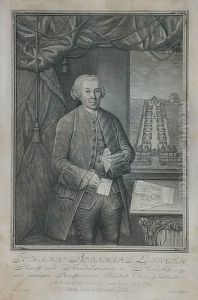Johann C Gottfried Fritzsch Paintings
Johann Christian Gottfried Fritzsch was a German engraver and publisher, born in 1668 in Hamburg, Germany. His work and career were primarily centered around the late 17th and early 18th centuries, a period that witnessed the flourishing of engraving as an art form across Europe. Fritzsch's contributions to the art world, although not as widely recognized as some of his contemporaries, played a significant role in the development and dissemination of engraving techniques and styles of the Baroque period.
Fritzsch's early life and training are not extensively documented, but it is known that he was active in Hamburg and developed his skills under the influence of the vibrant artistic environment of the city. Hamburg, being a major port city, was a melting pot of cultural and artistic influences, which undoubtedly shaped Fritzsch's artistic development. He became known for his detailed and precise engravings, which often depicted religious scenes, portraits, and landscapes. His works were characterized by their intricate detail and the ability to capture the essence of his subjects with remarkable clarity.
Throughout his career, Johann Christian Gottfried Fritzsch worked closely with publishers and other artists, contributing to various projects and publications. He was part of the broader network of engravers and artists who collaborated to produce books, illustrations, and artworks that were highly sought after by the burgeoning middle class and the aristocracy of the time. Fritzsch's engravings not only served as standalone pieces of art but were also instrumental in illustrating scientific and literary works, thereby helping to disseminate knowledge and culture.
Despite his contributions to the art of engraving and the cultural life of Hamburg and beyond, Fritzsch's name is not as prominently featured in art historical narratives as some of his peers. This oversight may be due in part to the vast number of artists working in similar mediums during this period, as well as the challenges in attributing works to specific artists when signatures were not always included or have faded over time. Nonetheless, Johann Christian Gottfried Fritzsch remains an important figure in the study of Baroque engraving for his technical skill, artistic vision, and the role he played in the cultural exchanges of his time.
Johann Christian Gottfried Fritzsch passed away in 1728. His legacy is preserved in collections and archives that hold examples of his work, offering insights into the artistic trends and techniques of his era. Through these surviving pieces, Fritzsch continues to contribute to our understanding of the Baroque period's artistic landscape, demonstrating the enduring impact of even those artists who may not have achieved widespread fame during their lifetimes.
